
Asian Traditional Archery Research Network (ATARN)
Text and
photographs © Stephen Selby, 2001 - 2002.
A1, Cloudridge,
30, Plunkett’s Road,
The Peak, Hong Kong.
Fax: (852) 2808-2887
email: srselby@atarn.org
March 2002
Dear All,
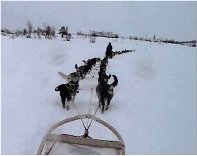 Hong
Kong is a sub-tropical place, so my ten-year-old daughter has never seen
snow. To cure that (with a vengeance), I took my whole family to the Arctic
Circle in Trømsø,
Norway for the Chinese New Year Holiday.
Hong
Kong is a sub-tropical place, so my ten-year-old daughter has never seen
snow. To cure that (with a vengeance), I took my whole family to the Arctic
Circle in Trømsø,
Norway for the Chinese New Year Holiday.
Norway is a beautiful country with friendly people. We visited a very nice village called 'Hell' (frozen over) and in Trømsø there are some excellent museums that offer a view of the pre-history and modern life of the European Arctic peoples - particularly the Sapmi (Saami - related to the Lapps).
The Sapmi followed reindeer herds on their migration paths, and in the North-west of Mongolia, in the Altai mountains, the Tsaatang people have many cultural parallels to the Sapmi, including riding reindeer and making birch bark sleds drawn by reindeer for carrying infants.
The Sapmi can be regarded as an Asian archery culture, given the wide range of their migrations. They used recurve bows made with wood and sinew, and such bows can be seen in rock carvings such as those found at Alta, on the Northern coast of Norway.

Rock carving from Alta, Norway.
But how old are they? Thousands of years,
or dating from Christian suppression of
Sapmi traditional beliefs
in the 17th - 18th Centuries?
Explorers in the 18th Century still observed these slightly recurved bows among the Sapmi.
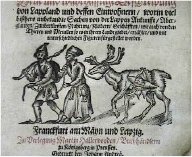
Sapmi (Lapp) man (with bow over his shoulder)
on the frontispiece of an 18thy Century book.
(Trømsø University
Museum)
Displays in the Trømsø University also include a partial Sapmi bow and crossbow. Unfortunately, the bow was in too poor condition (only the wooden core remained) to allow for a meaning photograph.

Sapmi Crossbow, 19th Century.
(Trømsø University
Museum)
You will recall that some time ago, I described a bone insert from a bow dating back to the Khitan culture, which derived from the Huns and dominated north China in the 10 - 11th Centuries.
Recently, I obtained two more fragments of bows. I have to make it clear that I have no proof that these items are parts of bows. They were not found with other recognizable parts of bows.
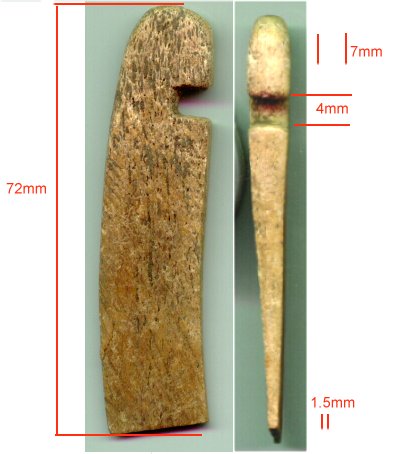
This is the item I showed earlier. It appears to me to be a bow-tip
insert.
The new items are made of bone (not horn) and appear to be grip-reinforcements. Their general age and the condition of the bone suggests that they are contemporaneous with the insert described above. Although I have two, they do not seem to be a pair as they vary slightly in size and state of preservation. Apart from the shape, which would plausibly indicate that they formed a reinforcement to the grip and the lower, non-working parts of the limb, the items are clearly scored on the inner surface in exactly the same way that I have seen modern horn bowyers use to ensure maximum adhesion between horn and wood. Let the pictures below speak for themselves.
Front and rear views of the bone grip reinforcement.
(Both are views of the same item.)
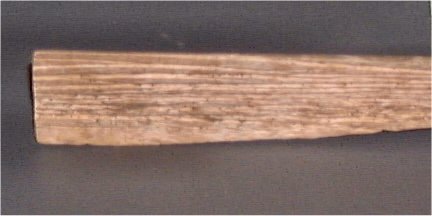
Oblique view of the inside showing scoring.
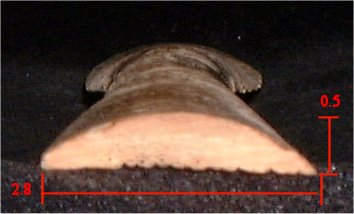
The end of the grip reinforcement where it would have abutted the horn.

Lateral view of the reinforcement. Note the even depth.
Of course, I can accept that this item might have had another use. But the scoring seems to me to be a give-away. What other usage would have required such precautions to ensure a firm glue bond?
I look forward to hearing Member's comments. Please could you open correspondence on AtarnNet under 'hardware' if you want to have a discussion?
In May, ATARN and the Hong Kong Museum of Coastal Defense will undertake an expedition to Qinghai and Xinjiang, in Western China (Mongolo-Tibetan and Muslim Uighur cultures respectively), to collect data on traditional archery and bow-making in the two regions. This promises to offer an excellent opportunity to expand our knowledge and out-reach to two of the archery cultures of China. We also hope to examine the Niya bow first-hand and prepare a technical report. I hope to be able to report in June this year.
With the assistance of Volker Tank in Germany, ATARN has commissioned a new English translation of the Sanskrit classic on archery, the Dhanurveda from Sanskrit scholar Dr. B Chakravarti. I will up-load it this month.
|
|
(Signed) (Stephen Selby) |